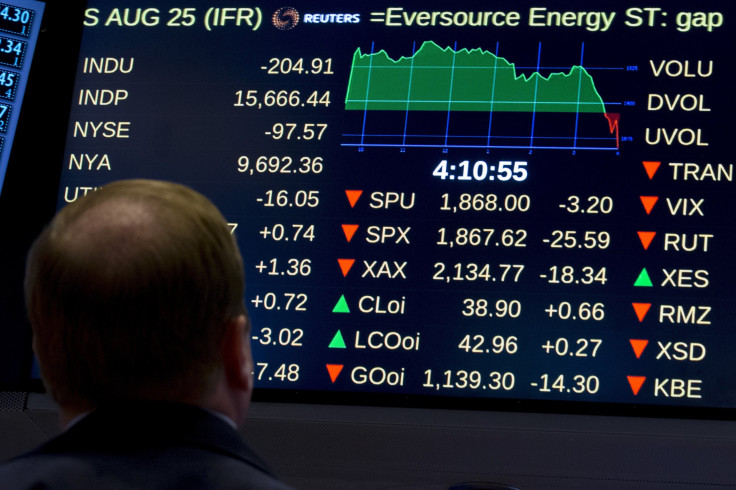Dow Jones Industrial Average Drops As Wall Street Weighs Federal Reserve Uncertainty, Looming Government Shutdown

This story was updated at 4 p.m. EDT
U.S. stocks closed sharply lower Monday, with the Dow Jones Industrial Average plunging 300 points, as market professionals looked ahead to a busy week filled with multiple speeches from top Federal Reserve officials, which could provide more clues as to the timing of the central bank’s inevitable rate hike. Investors are also weighing a looming government shutdown in the middle of the week, followed by a highly anticipated employment report for September -- due out Friday -- that might shed more light on whether the Fed will lift rates this year.
Experts say volatility in the financial markets is likely to stay elevated this week. “Investors remain on edge, largely in pause mode to a degree after more questions than answers surfaced at the end of last week regarding global economic turmoil and the Fed’s decision to not raise rates,” said Terry Sandven, chief equity strategist at U.S. Bank Wealth Management.
The resignation of Speaker of the House John Boehner could also add complexity to market dynamics in the near term. While his decision to step down seemingly reduces the likelihood of a government shutdown, the debt ceiling still remains a work in progress, Sandven said.
“In aggregate, political wrangling and brinkmanship will weigh on investor sentiment and even equity prices over the next few days and weeks,” Sandven said.
The Dow Jones Industrial Average (INDEXDJX:.DJI) tumbled 312 points, or 1.92 percent, to 16,002.20. The Standard & Poor's 500 index (INDEXSP:.INX) fell 49.49 points, or 2.6 percent, to 1,881.83. The Nasdaq composite (INDEXNASDAQ:.IXIC) lost 142.53 points, or 3 percent, to 4,543.97.
All of the 10 S&P 500 sectors traded lower, led by a more than 3 percent drop in healthcare, energy and material stocks. Dow components Visa Inc. (NYSE:V) and Goldman Sachs Group Inc. (NYSE:GS) led the index lower, shedding 4.7 percent and 3.6 percent, respectively.
The Nasdaq composite dropped nearly 3 percent, weighed down by losses in biotech stocks as the iShares Nasdaq biotechnology ETF sank more than 5 percent.
Energy stocks dropped after West Texas Intermediate crude, the benchmark for U.S. oil prices, fell 2.8 percent to $44.43 per barrel for November delivery on the New York Mercantile Exchange. On the London ICE Futures Exchange, Brent crude, the global benchmark for oil prices, dropped 2.5 percent to $48 a barrel.
Despite the Fed's hesitancy to raise rates at the central bank's Sept. 16-17 meeting, policy officials since have seemed focused on shaping expectations for a rate hike in 2015.
A top Fed official said the central bank will likely raise rates later this year. William Dudley, president and CEO of the Federal Reserve Bank of New York, said the U.S. economy is doing “pretty well,” and if it continues on this path, it could make for a strong case for a rate hike. Dudley is a voting member on the Fed's policy setting committee.
Following his speech, the yield on the 10-year Treasury note fell to 2.1 percent.
Dudley’s comments followed remarks by Fed Chair Janet Yellen that she expects the central bank to lift rates this year. Yellen is scheduled to speak Wednesday at the St. Louis Fed community banking conference.
However, Charles Evans, president and CEO of the Federal Reserve Bank of Chicago, said the Fed should delay a liftoff until next year.
"Before raising rates, I would like to have more confidence than I do today that inflation is indeed beginning to head higher," Evans said in prepared remarks for a speech in Milwaukee Monday. “I think the best policy is to take a very gradual approach to normalization.”
John Williams, the president and CEO of the Federal Reserve Bank of San Francisco, is scheduled to speak at the University of California, Los Angeles, Anderson Forecast conference, in Los Angeles at 5 p.m. EDT.
Global shares traded mixed Monday, with China’s benchmark Shanghai Composite index closing up 0.28 percent while Japan’s Nikkei index closed down 1.3 percent.
Asian markets closed mixed Monday after data from China showed industrial profits dropped 8.7 percent in August from a year earlier, marking their biggest drop since 2011. The data provided further evidence of weakness in the world's second largest economy.
European stocks traded lower, with Germany's DAX and France's CAC closing down 2.1 percent and 2.8 percent, respectively.
On the economic front, U.S. consumer spending, which accounts for more than two-thirds of economic activity, rose stronger-than-expected in August, signaling American households' spending habits spilled over into to third quarter after a weak first quarter due to harsh winter weather. The data add further evidence the Federal Reserve could raise interest rates sometime this year.
Consumer spending rose 0.4 percent after an upwardly revised 0.4 percent rise in July, the Commerce Department said Monday. The data come after the government's second revision for second-quarter gross domestic product was revised higher to 3.9 percent, boosted by stronger consumer spending and construction.
Meanwhile, inflation remained muted, rising just 0.3 percent in August from the same month a year earlier.
However, the Fed’s preferred measure of inflation showed signs of firming. The so-called core PCE price index, which excludes food and energy, rose 1.3 percent.
The Fed’s preferred inflation gauge continued to run below the Fed's 2 percent target last month for 40 consecutive months, marking the longest such stretch of sub-2 percent inflation since the 1960s. The last time the inflation rate was on target was in April 2012.
© Copyright IBTimes 2025. All rights reserved.






















